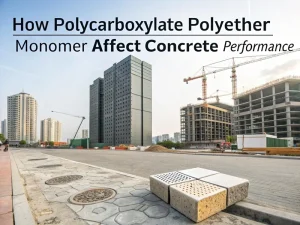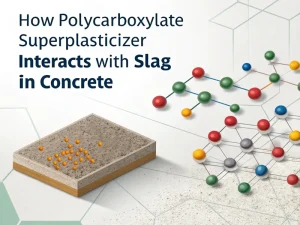Blog

With the increasing demand for stronger, more durable, and more feasible concrete in large-scale infrastructure projects such as skyscrapers, bridges, and dams, TPEG 2400 plays a crucial role in meeting these requirements.
TPEG 2400 or isopentenyl polyoxyethylene ether is synthesized mainly from isopentenyl and ethylene oxide, with the molecular formula:
CH2=C(CH3)CH2O(CH2CH2O)nH
Its molecular structure consists of a hydrophobic isopentenyl group at one end and a hydrophilic polyoxyethylene chain at the other end. The molecular weight of polyoxyethylene chains is relatively high, around 2400, and typically contains a large number of repeated ethylene oxide units.
This unique structure endows TPEG 2400 with amphiphilicity, enabling it to effectively interact with hydrophobic cement particles and hydrophilic water molecules in concrete mixtures.
Appearance: TPEG 2400 typically appears as a white to off-white, freely flowing powder or granular solid at room temperature.
Solubility: It exhibits excellent solubility in water, and once dissolved, it can be uniformly dispersed throughout the entire concrete mixture, ensuring consistent performance.
Stability: TPEG 2400 is stable under normal storage conditions and has a long shelf life. However, like many chemicals, it should be stored in a cool and dry place, away from direct sunlight and heat sources, to prevent degradation.
The double bond in the isopentenyl group of TPEG 2400 provides high reactivity. This enables it to participate in copolymerization reactions with various unsaturated monomers, such as acrylic acid, methacrylic acid, and their derivatives. Through these copolymerization reactions, TPEG 2400 forms the skeleton of a polycarboxylate superplasticizer, which is widely used in modern concrete technology.
Polycarboxylate superplasticizer is synthesized by copolymerizing TPEG 2400 with other monomers in aqueous solution. The copolymerization reaction is usually initiated by free radical initiators.
For example, in common synthesis methods, TPEG 2400 is copolymerized with acrylic acid. The free radical initiator decomposes to produce free radicals, which then react with the double bond of TPEG 2400 and acrylic acid. This process results in the formation of copolymers with comb-like structures, where the polyoxyethylene chains of TPEG 2400 act as side chains, and the acrylic units form the main chain.
Dispersion ability: The polyoxyethylene side chains of TPEG 2400 in polycarboxylate superplasticizer provide steric hindrance. When superplasticizers are added to concrete mixtures, they will adsorb onto the surface of cement particles. Long polyoxyethylene side chains extend into the surrounding water, forming a physical barrier to prevent cement particles from aggregating. This leads to good dispersion of cement particles in concrete, reduces internal friction, and improves the workability of concrete mixtures.
Water reduction efficiency: The highly efficient polycarboxylate superplasticizer based on TPEG 2400 effectively reduces the required moisture content in concrete mixtures while maintaining the required workability. The optimal molecular structure provided by TPEG 2400 allows for high water reduction rates, typically between 20% and 40%. This reduction in moisture content not only enhances the strength of concrete but also improves its durability by reducing the porosity and permeability of hardened concrete.
Slump retention: In addition to its ability to reduce water and disperse, TPEG 2400 also helps maintain the slump of concrete. The copolymer formed with TPEG 2400 can maintain the fluidity of concrete mixtures for a longer period. This is particularly important in large-scale construction projects, as concrete needs to be transported over long distances or poured in complex forms over a considerable amount of time.
Enhanced mechanical properties: Concrete produced using TPEG 2400-based polycarboxylate superplasticizer has excellent mechanical properties. The reduced water-cement ratio results in higher compressive and tensile strength. The improvement of cement particle dispersion also enhances the bonding strength between cement matrix and aggregate, thereby strengthening the overall integrity of concrete.
Improving durability: The use of TPEG 2400 in concrete formulations has achieved a denser microstructure, significantly enhancing its durability. The decrease in porosity reduces the permeability of concrete to water and harmful ions, protecting it from the effects of freeze-thaw cycles, chemical erosion, and carbonation. This means that structures made of this concrete have a longer service life, reducing the need for frequent maintenance and replacement.
Reduce cement consumption: By reducing the water-cement ratio while maintaining workability, the TPEG 2400-based high-efficiency water reducer can reduce the amount of cement required in concrete mixtures. Due to cement being one of the most expensive components in concrete, significant cost savings can be achieved in large-scale construction projects.
Improve productivity: TPEG 2400-derived high-efficiency water reducer has excellent processability and slump retention, which can improve construction productivity. Concrete can be poured faster and easier, reducing labor costs and construction time. For example, in the construction of high-rise buildings, due to the improvement of concrete fluidity, the pouring speed of concrete is faster, which can accelerate the overall construction progress.
Reducing carbon footprint: Using TPEG 2400 in concrete can reduce cement consumption and have a positive impact on the environment. Cement production is a highly energy-consuming process that emits a large amount of carbon dioxide. By using less cement in concrete mixtures, the carbon footprint of construction projects can be significantly reduced.
Sustainable Building: A highly efficient polycarboxylate superplasticizer based on TPEG 2400 contributes to sustainable building practices. The improvement of concrete durability means a longer service life of the structure, reducing the demand for new building materials and related environmental impacts. In addition, by using these superplasticizers, the ability to use recycled aggregates in concrete mixtures has been enhanced, further promoting sustainable construction.
Polyether monomer TPEG 2400 has become an indispensable component in modern concrete technology. Its unique chemical structure and properties make it possible to produce high-performance polycarboxylate superplasticizers, which are crucial for manufacturing concrete with enhanced workability, strength, and durability.
From high-rise buildings to large-scale infrastructure projects, TPEG 2400-based concrete admixtures have proven their value in improving construction efficiency, reducing costs, and promoting sustainable buildings.
Despite the challenges that need to be overcome, ongoing research and development work may further expand the capabilities of TPEG 2400 and its application in the concrete industry, ensuring its continued importance in future construction.

How Polycarboxylate Polyether Monomer Affect Concrete Performance
Blog How Polycarboxylate

How Polycarboxylate Superplasticizer Interacts With Slag In Concrete
Blog How Polycarboxylate